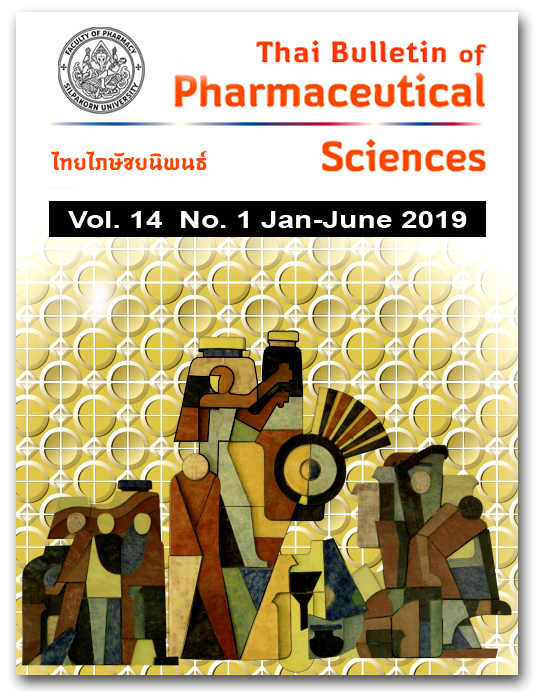การใช้ยาที่ไม่เหมาะสมตามเกณฑ์ประเทศไทยในกลุ่มผู้สูงอายุที่อาศัยอยู่ในชุมชนเมือง: ความชุก รายการยา และปัจจัยสัมพันธ์
DOI:
https://doi.org/10.69598/tbps.14.1.49-63คำสำคัญ:
ผู้สูงอายุ, ยาที่ไม่เหมาะสม, เกณฑ์ประเทศไทย, ความชุก, ปัจจัยสัมพันธ์บทคัดย่อ
ในประเทศไทยได้มีการพัฒนาเกณฑ์รายการยาที่มีความเสี่ยงในการใช้สำหรับผู้สูงอายุไทย แต่ยังไม่พบการนำเกณฑ์ดังกล่าวมาใช้เป็นเครื่องมือประเมินปัญหาการใช้ยาที่ไม่เหมาะสมในกลุ่มผู้สูงอายุที่อาศัยอยู่ในชุมชนเมือง การวิจัยนี้มีวัตถุประสงค์เพื่อหาความชุก รายการยาที่ไม่เหมาะสม และปัจจัยที่สัมพันธ์กับการใช้ยาที่ไม่เหมาะสม ผู้วิจัยทำการสำรวจเชิงวิเคราะห์แบบภาคตัดขวาง โดยเก็บข้อมูลการใช้ยาของผู้ที่มีอายุ 60 ปีขึ้นไปและอาศัยอยู่ในชุมชนเมืองจำนวน 7 ชุมชน จังหวัดพะเยา ระหว่างวันที่ 15 สิงหาคม 2559 ถึง 24 กุมภาพันธ์ 2560 รายการยาที่ไม่เหมาะสมถูกระบุโดยใช้เกณฑ์รายการยาที่มีความเสี่ยงในการใช้สำหรับผู้สูงอายุไทย ผลการสำรวจในกลุ่มตัวอย่าง 400 ราย เป็นเพศหญิงร้อยละ 67.3 และอายุเฉลี่ย 72.26 ± 8.73 ปี พบว่าร้อยละ 72.5 (95% CI = 67.8% – 76.8%) ของผู้สูงอายุกำลังใช้ยาที่ไม่เหมาะสมอย่างน้อย 1 รายการ โดยมีค่ามัธยฐานของจำนวนยาที่ไม่เหมาะสม 1 (1, 2) รายการ เมื่อพิจารณาตามกลุ่มอายุพบว่า ผู้สูงอายุ 60 – 74 ปี ใช้ยาที่ไม่เหมาะสม 3 อันดับแรก ได้แก่ amlodipine (ร้อยละ 18.9), orphenadrine (ร้อยละ 10.0) และ diclofenac กับ nifedipine SR (ร้อยละ 9.2 ต่อรายการ) ผู้สูงอายุ 75 ปีขึ้นไป ใช้ยาที่ไม่เหมาะสมที่พบสูงสุด คือ amlodipine (ร้อยละ 18.8) รองลงมาคือ nifedipine SR (ร้อยละ 11.6) และ orphenadrine (ร้อยละ 9.9) ปัจจัยที่สัมพันธ์กับการใช้ยาที่ไม่เหมาะสม ได้แก่ การมีรายรับ ³ 1,000 บาทต่อเดือน (adjusted OR = 1.83, 95% CI = 1.07 – 3.13, p = 0.028), การใช้อาหารเสริม/สมุนไพร (adjusted OR = 3.12, 95% CI = 1.16 – 8.39, p = 0.025), การใช้ยา 5 – 9 รายการ (adjusted OR = 2.45, 95% CI = 1.40 – 4.29, p = 0.002) และการใช้ยา ³ 10 รายการ (adjusted OR = 6.18, 95% CI = 1.68 – 22.74, p = 0.007) การใช้ยาที่ไม่เหมาะสมพบได้บ่อยในกลุ่มผู้สูงอายุที่อาศัยอยู่ในชุมชนเมือง ปัจจัยสัมพันธ์ที่พบในการศึกษานี้ คือ การมีรายรับสูง การใช้อาหารเสริมหรือสมุนไพร และการใช้ยาหลายขนาน
เอกสารอ้างอิง
2. National Statistical Office. The 2014 survey of the older persons in Thailand. Bangkok: Text and journal publication; 2014.
3. Prasartkul P. Situation of the Thai elderly 2014. Bangkok: Amarin Printing & Publishing; 2015.
4. Chiewchantanakit D, Kiatying-Angsulee N, Sirisinsuk Y. Medication use situation in Thai elderly: the computerized database from four tertiary care hospitals. TJHP. 2013;23(1):9-20.
5. Caslake R, Soiza RL, Mangoni AA. Practical advice for prescribing in old age. Medicine. 2013;41(1):9-12.
6. Food and Drug Administration. Spontaneous reports of adverse drug reactions 2016. Bangkok: Graphic & Design; 2017.
7. O'Connor MN, Gallagher P, O'Mahony D. Inappropriate prescribing: criteria, detection and prevention. Drugs Aging. 2012;29(6):437-52.
8. Gallagher P, Ryan C, Byrne S, Kennedy J, O'Mahony D. STOPP (Screening Tool of Older Person's Prescriptions) and START (Screening Tool to Alert doctors to Right Treatment). consensus validation. Int J Clin Pharmacol Ther. 2008;46(2):72-83.
9. Azermai M, Vander Stichele RR, Elseviers MM. Quality of pharmacotherapy in old age: focus on lists of potentially inappropriate medications (PIMs) : consensus statements from the European Science Foundation exploratory workshop. Eur J Clin Pharmacol. 2016;72(7):897-904.
10. Hamilton HJ, Gallagher PF, O'Mahony D. Inappropriate prescribing and adverse drug events in older people. BMC geriatrics. 2009;9:5.
11. Lucchetti G, Lucchetti AL. Inappropriate prescribing in older persons: A systematic review of medications available in different criteria. Arch Gerontol Geriatr. 2017;68:55-61.
12. Kaufmann CP, Tremp R, Hersberger KE, Lampert ML. Inappropriate prescribing: a systematic overview of published assessment tools. Eur J Clin Pharmacol. 2014;70(1):1-11.
13. Kashyap M, Iqbal MZ. A review of screening tools used for the assessment of appropriateness of prescription’s among elderly patients. J Pharm Bio Sci. 2014;3:72-9.
14. Fick DM, Mion LC, Beers MH, J LW. Health outcomes associated with potentially inappropriate medication use in older adults. Res Nurs Health. 2008;31(1):42-51.
15. Cahir C, Bennett K, Teljeur C, Fahey T. Potentially inappropriate prescribing and adverse health outcomes in community dwelling older patients. Br J Clin Pharmacol. 2014;77(1):201-10.
16. Ploylearmsang C, Kerdchantuk P, SoonKang K, Worasin P, Kedhareon P. Drug-related problems and factors affecting on drug use problems in elderly of Banmakok, Kantharawichai, Maha Sarakham Province. J Sci Technol MSU. 2013:803-12.
17. Bua-Khwan W, Pichayapaiboon S. Potentially Inappropriate Medication Usage by Nursing Home Residents. TJPP. 2016;8(1):3-14.
18. Baldoni Ade O, Ayres LR, Martinez EZ, Dewulf Nde L, Dos Santos V, Pereira LR. Factors associated with potentially inappropriate medications use by the elderly according to Beers criteria 2003 and 2012. Int J Clin Pharm. 2014;36(2):316-24.
19. Tommelein E, Mehuys E, Petrovic M, Somers A, Colin P, Boussery K. Potentially inappropriate prescribing in community-dwelling older people across Europe: a systematic literature review. Eur J Clin Pharmacol. 2015;71(12):1415-27.
20. Hudhra K, Garcia-Caballos M, Casado-Fernandez E, Jucja B, Shabani D, Bueno-Cavanillas A. Polypharmacy and potentially inappropriate prescriptions identified by Beers and STOPP criteria in co-morbid older patients at hospital discharge. J Eval Clin Pract. 2016;22(2):189-93.
21. Nauta KJ, Groenhof F, Schuling J, Hugtenburg JG, van Hout HPJ, Haaijer-Ruskamp FM, et al. Application of the STOPP/START criteria to a medical record database. Pharmacoepidemiol Drug Saf. 2017;26(10):1242-7.
22. Ploylearmsang C, Tieankanitikul K, ChobPradit J, Suntorn S, Suwankasawong W. Development of medicine list for screening and reducing medication-related problems in Thai elderly. Bangkok: Health systems research institute (HSRI); 2013. Contract No.: IHPF/QUM 058-04/2554, Sponsored by International health policy program foundation (IHPP).
23. Prasert V, Akazawa M, Shono A, Chanjaruporn F, Ploylearmsang C, Muangyim K, et al. Applying the Lists of Risk Drugs for Thai Elderly (LRDTE) as a mechanism to account for patient age and medicine severity in assessing potentially inappropriate medication use. Res Social Adm Pharm. 2017.
24. Chaimay B. Sample size determination in descriptive study in public health. Thaksin J. 2013;16(2):9-18.
25. Kaiyawan Y. Principle and using logistic regression analysis for research. RMUTSV Res J. 2013;4(1):1-12.
26. Tosato M, Landi F, Martone AM, Cherubini A, Corsonello A, Volpato S, et al. Potentially inappropriate drug use among hospitalised older adults: results from the CRIME study. Age Ageing. 2014;43(6):767-73.
27. Thavornwattanayong W, Anothayanon J, Reungsakul N, Sriphiromrak P, R C. High-risk medication use in Thai elderly patients: case study in Wangtaku subdistrict, Nakhonpathom. J Health Syst Res. 2011;5(2):187-94.
28. de Lima TJV, Garbin CAS, Garbin AJÍ, Sumida DH, Saliba O. Potentially inappropriate medications used by the elderly: prevalence and risk factors in Brazilian care homes. BMC geriatrics. 2013;13(1):52.
29. Limpawattana P, Kamolchai N, Theeranut A, Pimporn J. Potentially inappropriate prescribing of Thai older adults in an internal medicine outpatient clinic of a tertiary care hospital. Afr J Pharm Pharmacol 2013;7(34):2417-22.
30. Elmståhl S, Linder H. polypharmacy and inappropriate drug use among older people—a systematic Review. Healthy Aging Clin Care Elder. 2013;2013(5):1-8.



